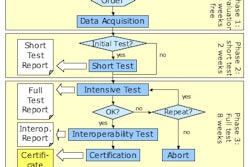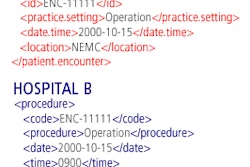NEW ORLEANS - The booming market for health informatics professionals can make it difficult for organizations to find qualified staff for available positions. To help address this shortage, Canadian health informatics association COACH is working to build its nation's health informatics capacity through an initiative called HIP (Health Informatics Professional).
"We have certainly moved from finding jobs for people to finding people for jobs," said past COACH president Don Newsham.
Newsham spoke along with Neil Gardner, executive director of the Health Information Solutions Centre at Saskatchewan Health in Regina, Saskatchewan, during a session at this week's annual meeting of the Health Information Management Systems Society (HIMSS).
In today's health informatics world, finding, training, and retaining employees are as important as finding the dollars for them, he said. One of the big drivers for health informatics professionals is the safety of software products, according to Newsham.
"Health informatics professionals have an ethical duty to be (experts) and provide their expertise effectively in their job," he said. "Safety in products and software is really an important issue. Do we have an adequate professional workforce to achieve a safe product?"
With a high demand and diminishing supply for health informatics professionals, the time to act is now, Newsham said.
Building health informatics capacity is a complex and major challenge and may involve a hierarchy of approaches, including registration (or rostering), certification, and potentially licensure, Gardner said. The effort is building upon existing models, and is working to reach consensus, he said.
Tools in the process include white papers, green papers, forums, expert groups, and workshops.
"We really need to start understanding what we need when we talk about a health informatics professional and what makes up this unique beast that brings together knowledge from several different disciplines," he said.
The initiative involves four steps: fundamentally defining the profession, determining what it means to be a HIP, identifying a path for evolving health informatics as a profession, and gathering support for credentialing with the employing community.
In looking at COACH's membership, people tend to come to health informatics from previous roles as traditional information managers and technologists, other healthcare fields, and healthcare business or policy positions, according to Gardner.
"Fundamentally, the challenge really is defining, given people come in pretty much with a preexisting credential. What's that core of knowledge that they need to have beyond the credential that they began with to be considered a health informatrician?" he said.
In designing and moving down this path to professionalism, the HIP initiative is utilizing a collaborative approach that engages key stakeholders, builds on existing knowledge and resources, uses a best-practices approach, is transparent, and aims to be feasible and sustainable, he said. It should also be flexible to allow for future developments.
HIP is a strategy to evolve the practice of health informatics to the point it increasingly assumes the characteristics of a profession, according to Gardner. This will include mastery of a unique body of knowledge and a code of ethics, he said.
A HIP green paper has been completed, which identified two options for consideration. The first option, rostering and credential review, would involve setting up a roster of health informatics professionals who have met specific requirements in terms of education and experience. The second option, credential review and examination, would involve setting up a two-step process.
In the first step, education and experience credentials would be reviewed to determine eligibility. The second step would consist of an examination based on current practice in Canada, but utilizing existing work as much as possible, according to the presenters.
In a 2006 survey from a COACH workshop on the top five reasons for credentialing, 62.3% respondents wanted to establish minimum competency standards, 39.1% wanted to establish a common body of knowledge, 36.2% wanted to promote best practices, 30.4% wanted to enhance professionalism in the industry, and 20.3% sought to ensure health informatics professionals maintain currency.
Both of the considered options in the green paper were considered to have their strengths and weaknesses, according to the speakers. Some focus groups preferred the second option, while others developed suggestions for a hybrid model.
Moving forward, the initiative will test and build consensus on the definition of health informatics, discussing it with members at upcoming workshops and conferences, Gardner said.
"It's going to be very important that whatever we do, there is lots of understanding and buy-in for the approach," Gardner said. "We will look at, as an organization, developing our business case around where do we want to go, especially (in regards to) the issue of credentialing and rostering."
In Canada and in most countries, health informatics is at an important crossroad in its development, Gardner concluded.
"It's not a question of whether we need to move down the professionalism path," he said. "It's a question of how fast and how far."
By Erik L. Ridley
AuntMinnie.com staff writer
February 28, 2006
Related Reading
EHR deployment presents familiar obstacles, February 27, 2007
Alaska telehealth project improves efficiency, access to care, February 27, 2007
U.S. takes steps to ramp up HIT efforts, February 23, 2007
CCHIT certifies 18 EHR products, January 30, 2007
CCHIT releases interoperability test scripts, data files, January 5, 2007
Copyright © 2007 AuntMinnie.com




















